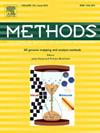Development and optimization of an antibody-free nucleic acid lateral flow assay (AF-NALFA) as part of a molecular toolkit for visual readout of amplified Listeria monocytogenes DNA
IF 4.3
3区 生物学
Q1 BIOCHEMICAL RESEARCH METHODS
引用次数: 0
Abstract
Listeria monocytogenes is a Gram-positive foodborne pathogen responsible for listeriosis, a severe disease with high mortality in immunocompromised individuals. Rapid and accurate detection in food samples is essential for food safety. In this study, we developed and optimized an Antibody-Free Nucleic Acid Lateral Flow Assay (AF-NALFA) as part of a molecular detection toolkit for the visual readout of amplified L. monocytogenes hlyA gene, in combination with ultra-fast asymmetric PCR (aPCR) and oligonucleotide probe hybridization. Three critical parameters were optimized: oligonucleotide probe concentration on test and control lines, gold nanoparticle-probe conjugation ratio, and running buffer composition. In pure bacterial cultures, the limit of detection (LOD) of AF-NALFA was 12.62 copies for L. monocytogenes ATCC 7644, 8.68 copies for ATCC 19117, and 4.83 copies for ATCC 13932. These values were quantitatively assessed using qPCR, confirming the assay’s consistency in detecting low DNA copy numbers. The prototype demonstrated 100% specificity against 13 other bacterial species. Furthermore, it was successfully tested in artificially contaminated UHT milk after 1 year of storage at room temperature, detecting L. monocytogenes at 1–30 CFU/mL without DNA purification or selective enrichment. The AF-NALFA enabled visual detection of target ssDNA hybridization within 20 min, offering a rapid, cost-effective alternative to DNA detection methods requiring expensive equipment, specialized expertise, and time-consuming procedures. These findings highlight AF-NALFA’s potential as a complementary tool for L. monocytogenes surveillance, providing a practical solution for rapid screening in food safety laboratories and epidemiological monitoring.
开发和优化无抗体核酸侧流测定(AF-NALFA),作为分子工具包的一部分,用于扩增单核细胞增生李斯特菌DNA的视觉读取
单核细胞增生李斯特菌是一种革兰氏阳性食源性病原体,导致李斯特菌病,这是一种在免疫功能低下个体中具有高死亡率的严重疾病。食品样品的快速准确检测对食品安全至关重要。在这项研究中,我们开发并优化了一种无抗体核酸侧流法(AF-NALFA),作为分子检测工具包的一部分,结合超快速不对称PCR (aPCR)和寡核苷酸探针杂交,用于扩增单核增生乳杆菌hlyA基因的视觉读取。优化了3个关键参数:寡核苷酸探针在测试线和控制线上的浓度、金纳米粒子与探针的共轭比、运行缓冲液的组成。在纯细菌培养中,单核增生L. L. ATCC 7644、ATCC 19117和ATCC 13932的AF-NALFA检出限分别为12.62、8.68和4.83。使用qPCR对这些值进行了定量评估,证实了该方法在检测低DNA拷贝数方面的一致性。该样品对其他13种细菌具有100%的特异性。此外,在室温下保存1年后,在人工污染的UHT牛奶中成功检测到1 - 30 CFU/mL的单核细胞增多乳杆菌,无需DNA纯化或选择性富集。AF-NALFA能够在20分钟内对目标ssDNA杂交进行视觉检测,为需要昂贵设备、专业知识和耗时程序的DNA检测方法提供了一种快速、经济高效的替代方法。这些发现突出了AF-NALFA作为单核增生乳杆菌监测补充工具的潜力,为食品安全实验室的快速筛查和流行病学监测提供了实用的解决方案。
本文章由计算机程序翻译,如有差异,请以英文原文为准。
求助全文
约1分钟内获得全文
求助全文
来源期刊

Methods
生物-生化研究方法
CiteScore
9.80
自引率
2.10%
发文量
222
审稿时长
11.3 weeks
期刊介绍:
Methods focuses on rapidly developing techniques in the experimental biological and medical sciences.
Each topical issue, organized by a guest editor who is an expert in the area covered, consists solely of invited quality articles by specialist authors, many of them reviews. Issues are devoted to specific technical approaches with emphasis on clear detailed descriptions of protocols that allow them to be reproduced easily. The background information provided enables researchers to understand the principles underlying the methods; other helpful sections include comparisons of alternative methods giving the advantages and disadvantages of particular methods, guidance on avoiding potential pitfalls, and suggestions for troubleshooting.
 求助内容:
求助内容: 应助结果提醒方式:
应助结果提醒方式:


